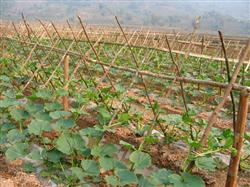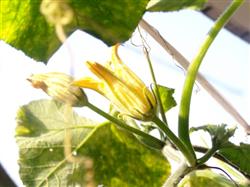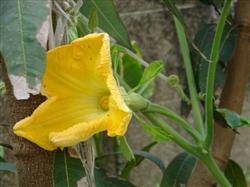How to fertilize pumpkins?

How to fertilize pumpkins? Please introduce in detail that the fertilization of pumpkin can be carried out according to the following methods: (1) cultivating strong seedlings: there are two ways of pumpkin cultivation: seedling transplanting and open field direct seeding. Seedling transplanting is carried out in early-maturing cultivation, and direct seeding can be adopted in middle and late-maturing cultivation. ① seedlings: early-maturing varieties include calf pumpkin, Guizhou small cucumber, Ye'er San pumpkin, small grinding plate, etc.; medium-maturing varieties have ten sisters pumpkin, Hanchuan persimmon, etc.; late-maturing varieties include Boshan long, pillow, iron, big grinding plate and so on. Early seedling raising and transplanting of pumpkin can prolong its growth period and help to obtain high yield and increase income. It is feasible to accelerate germination and sow after seed selection and disinfection treatment before sowing. The facilities for raising seedlings and the preparation of nutritious soil can refer to the contents of cucumber. The seedling age of early-maturing varieties was 40-45 days. Strong seedling standard: there are 3 true leaves on the ground, the plant height is 10-15 cm, the leaf is dark green, the stem is stout, the root system is developed and covered with soil blocks, and there are no diseases and insect pests. ② live broadcast in the open field: pumpkins cultivated in late maturity or sporadically planted beside houses and roadsides are all broadcast after the final frost period. Usually sprout first and then broadcast live. It can also be broadcast live with dry seeds. Direct seeding is simple and labor-saving, the root system is well developed, and the drought resistance is strong. Although the mature period is late, the yield is high and the quality is good. (2) re-application of base fertilizer and timely planting: pumpkin has well-developed root system and strong ability to absorb fertilizer. It should be turned 30 cm deep before winter and ploughed in the next spring. 75000 kg of rotten high-quality organic fertilizer per hectare should be sprinkled before turning the second plough or concentrated in the sowing border. After ploughing and leveling, make sowing or planting beds, planting about 4500 plants per hectare. After transplanting slow seedlings of pumpkin, if the seedling is weak and the leaves are light and yellow, you can apply fertilizer combined with watering, applying 3750-4500 kg of sparse dung water per hectare. When the plant enters the middle stage of growth and sits on 1 or 2 young melons, fruit-promoting fertilizer should be re-applied before the row is closed, generally 15000 ~ 22500 kg of rotten thin dung water or cake fertilizer water per hectare. During this period, some droughts can be combined with watering, and 225,300 kg / ha of compound fertilizer can be applied with water. After the fruit is harvested, a small amount of organic fertilizer can be applied to prevent the plant from senescence and increase the yield in the later stage. If you do not harvest tender melons, but are prepared to harvest mature melons, you do not have to fertilize them in the later stage, and only pay attention to watering or drainage. In the middle and later stages, 0.2% potassium dihydrogen phosphate can also be sprayed, once every 10 days and 2 times in a row. Pumpkin likes organic fertilizer, so the amount of fertilizer and nutrient combination should be determined according to plant growth and soil fertility. If the growing point of melon vine is strong and warped, it is not suitable to apply fertilizer when the leaf color is dark green, in order to prevent overgrowth and melons; if the leaf color is light green or yellow, it should be fertilized in time. Click to get more pumpkin planting techniques click to get more vegetable planting techniques
- Prev

Is there any way to prevent and cure pumpkin?
Is there any way to prevent and cure pumpkin? Please advise the phenomenon that pumpkins die when they grow to the size of their fists, which is called Hua Gua. The main reasons for pumpkin are: (1) the recent high temperature is not conducive to pumpkin fruit setting and fruit expansion, causing pumpkin. (2) too much fertilizer and water, especially in the south.
- Next

What method can pumpkin flower protect fruit?
What method can pumpkin flower protect fruit? Please introduce the pumpkin early growth of nitrogen fertilizer application too much, easy to plant excessive growth, resulting in flower and fruit drop phenomenon, can not ensure the uniformity of melon tidiness and final product quality. Therefore, it is necessary to control the amount of nitrogen fertilizer used and appropriately increase the proportion of phosphorus and potassium fertilizer. When needed,...
Related
- Where is it suitable to grow horseradish in China? it is expected to see the middle altitude horseradish in Alishan.
- How to prevent tomato virus disease reasonably? (Control methods included)
- Many people like to plant towel gourd on the balcony. What are the main points of this method and management?
- What crops can chili peppers be mixed with?
- Fertilization techniques and matters needing attention in Tomato
- What are the grafting techniques for peach seedlings in spring?
- Harm and control methods of root swelling disease of Chinese cabbage
- What are the pests of sweet potatoes? How to prevent and cure it?
- Symptoms, causes and Control methods of navel Rot in Tomato
- The cause of "Cucumber rotten bibcock" in Farmers' planting Cucumber and its Control Plan

